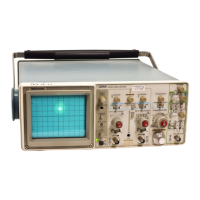Maintenance—2215A Service
6-4 are based on a system limited in bandwidth to 30 kHz
(greater bandwidth will result in higher readings).
If power supply voltages and ripple are within the listed
ranges, the supply can be assumed to be operating cor
rectly. If any are outside these ranges, the supply may be
either misadjusted or operating incorrectly. Use the “Power
Supply and CRT Display" part of the “Adjustment Proce
dure” section to adjust the —8.6 V supply.
A defective component elsewhere in the instrument can
create the appearance of a power-supply problem and may
also affect the operation of other circuits.
Table 6-4
Power Supply Limits and Ripple
Power Test Reading P-P Ripple
Supply Point (Volts)
(mV)
-8.6 V
TP961
-8.56 to -8.64 1.5
+ 5.2 V
W968
+ 5.04 to +5.36 3.0
+8.6 V W960 + 8.43 to +8.77
1.5
+ 30 V
W956
+ 29.1 to +30.9 20.0
+ 100 V
W954
+ 97.0 to +103.0 40.0
7. Check Circuit Board Interconnections
After the trouble has been isolated to a particular circuit,
again check for loose or broken connections and heat-dam
aged components.
8. Check Voltages and Waveforms
Often the defective component can be located by check
ing the appropriate voltage or waveform in the circuit. Typi
cal voltages are listed on the schematic diagrams.
Waveforms are shown adjacent to the schematics, and
waveform test points are indicated on both the schematics
and circuit board illustrations by hexagonal-outlined
numbers.
NOTE
Voltages and waveforms given on the schematic dia
grams are not absolute and may vary slightly between
instruments. To establish operating conditions simitar
to those used to obtain these readings, see the ‘ Volt
age and Waveform Setup’ conditions in the ‘ Dia
gram s’ section fo r the preliminary equipment setup.
Note the recommended test equipment, initial front-
panel control settings, and cable-connection instruc
tions. The control-setting changes (from initia l setup)
required to obtain the given waveforms and voltages
are located on the waveform-diagram page.
WARNING
To avoid electric shock, always disconnect the instru
ment from the pow er input source before removing or
replacing components.
9. Check Individual Components
The following procedures describe methods of checking
individual components. Two-lead components that are sol
dered in place are most accurately checked by first discon
necting one end from the circuit board. This isolates the
measurement from the effects of surrounding circuitry. See
Figure 9-1 for value identification or Figure 9-2 for typical
semiconductor lead configuration.
When checking semiconductors, observe the static-
sensitive precautions located a t the beginning o f this
section.
TRANSISTORS. A good check of transistor operation is
actual performance under operating conditions. A transistor
can most effectively be checked by substituting a known
good component. However, be sure that circuit conditions
are not such that a replacement transistor might also be
damaged. If substitute transistors are not available, use a
dynamic tester. Static-type testers are not recommended,
since they do not check operation under simulated operat
ing conditions.
When troubleshooting transistors in the circuit with a
voltmeter, measure both the emitter-to-base and emitter-to-
collector voltages to determine whether they are consistent
with normal circuit voltages. Voltages across a transistor
may vary with the type of device and its circuit function.
Some of these voltages are predictable. The emitter-to-
base voltage for a conducting silicon transistor will normally
range from 0.6 to 0.8 V. The emitter-to-collector voltage for
a saturated transistor is about 0.2 V. Because these values
are small, the best way to check them is by connecting a
sensitive voltmeter across the junction rather than compar
ing two voltages taken with respect to ground. If the former
method is used, both leads of the voltmeter must be isolated
from ground.
6-8

